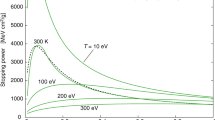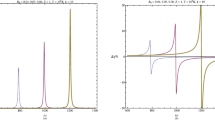Abstract
Physically realized electron gas systems usually reside in either the quantum non-degenerate or fully degenerate limit, where the average de Broglie wavelength of the thermal electrons becomes comparable with the interparticle distance between electrons. A few systems, such as young brown dwarfs and the cold dense fuels created in imploded cryogenic capsules at the National Ignition Facility, lie between these two limits and are partially degenerate. The National Ignition Facility has the unique capability of varying the electron quantum degeneracy by adjusting the laser drive used to implode the capsules. This allows experimental studies of the effects of the degeneracy level on plasma transport properties. By measuring rare nuclear reactions in these cold dense fuels, we show that the electron stopping power, which is the rate of energy loss per unit distance travelled by a charged particle, changes with increasing electron density. We observe a quantum-induced shift in the peak of the stopping power using diagnostics that measure above and below this peak. The observed changes in the stopping power are shown to be unique to the transition region between non-degenerate and degenerate plasmas. Our results support the screening models applied to partially degenerate astrophysical systems such as young brown dwarfs.





Similar content being viewed by others
References
Daligault, J. Crossover from classical to Fermi liquid behavior in dense plasmas. Phys. Rev. Lett. 119, 045002 (2017).
Salpeter, E. E. Electron screening and thermonuclear reaction rates. Aust. J. Phys. 7, 373–388 (1954).
Shternin, P. S. Shear viscosity of degenerate electron matter. J. Phys. A 41, 205501 (2008).
Maynard, G. & Deutsch, C. Born random phase approximation for ion stopping in an arbitrarily degenerate electron fluid. J. Phys. 46, 1113–1122 (1985).
Skupsky, S. Energy loss of ions moving through high-density matter. Phys. Rev. A 16, 727–731 (1977).
Dar, A., Grunzweig-Genossar, J., Peres, A., Revzen, M. & Rob, A. Slowing down of ions by ultrahigh-density electron plasma. Phys. Rev. Lett. 32, 1299–1301 (1974).
Li, C. & Pettrasso, R. D. Effects of scattering upon energetic ion energy loss in plasmas. Phys. Plasma 2, 2460–2464 (1995).
Brown, L. S. & Singleton, R. L. Jr Temperature equilibration rate with Fermi–Dirac statistics. Phys. Rev. E 76, 066404 (2007).
Lee, Y. T. & More, R. M. An electron conductivity model for dense plasmas. Phys. Fluids 27, 1273–1286 (1984).
Longair, M. S. The Cosmic Century: A History of Astrophysics and Cosmology (Cambridge Univ. Press, 2006).
Marshak, R. E. The internal temperature of white dwarf stars. Astrophys. J. 92, 321–353 (1940).
Lattimer, J. M. & Prakash, M. The physics of neutron stars. Science 304, 536–542 (2004).
Ashcroft, N. W. & Mermin, N. D. Solid State Physics (Harcourt School, 1987).
Burrows, A. & Liebert, J. The science of brown dwarfs. Rev. Mod. Phys. 65, 301–336 (1993).
Lindl, J. Development of the indirect-drive approach to inertial confinement fusion and the target physics basis for ignition and gain. Phys. Plasmas 2, 3933–4024 (1995).
Edwards, M. J. et al. Progress towards ignition on the National Ignition Facility. Phys. Plasmas 20, 070501 (2013).
Brown, L. S., Preston, D. L. & Singleton, R. L. Jr Charged particle motion in a highly ionized plasma. Phys. Rep. 410, 237–333 (2005).
Evans, P. M., Fews, A. P. & Toner, W. T. Diagnosis of laser produced plasmas using fusion reaction products. Laser Part. Beams 6, 353–360 (1988).
Deutsch, C. & Maynard, G. et al. Ion stopping in dense plasma target for high energy density physics. Open Plasma Phys. J. 3, 88–115 (2010).
Zylstra, A. B. et al. Measurements of charged-particle stopping in warm dense plasma. Phys. Rev. 114, 215002 (2015).
Frenje, J. A. et al. Measurements of ion stopping around the Bragg peak in high-energy-density plasmas. Phys. Rev. Lett. 115, 205001 (2015).
Hopkins, L. Berzak et al. Increasing stagnation pressure and thermonuclear performance of inertial confinement fusion capsules by the introduction of a high-Z dopant. Phys. Plasmas 25, 080706 (2018).
Divol, L. et al. Symmetry control of an indirectly driven high-density-carbon implosion at high convergence and high velocity. Phys. Plasmas 24, 056309 (2017).
Hinkel, D. E. et al. Development of improved radiation drive environment for high foot implosions at the National Ignition Facility. Phys. Rev. Lett. 117, 225002 (2016).
Hinkel, D. E. et al. Publisher’s note: development of improved radiation drive environment for high foot implosions at the National Ignition Facility. Phys. Rev. Lett. 118, 089902 (2017).
Hayes, A. C. et al. Reaction-in-flight neutrons as a test of stopping power in degenerate plasmas. Phys. Plasmas 22, 082703 (2015).
Hayes, A. C., Bradley, P. A., Grim, G. P., Jungman, G. & Wilhelmy, J. B. Reaction-in-flight neutrons as a signature for shell mixing in National Ignition Facility capsules. Phys. Plasmas 17, 012705 (2010).
Hayes, A. C. et al. Reaction-in-flight neutrons as a test of stopping power in degenerate plasmas. J. Phys. Conf. Ser. 717, 012022 (2016).
Gooden, M. E. et al. Measurement of the 209Bi(n, 4n) 206Bi and 169Tm(n, 3n) 167Tm cross sections between 23.5 and 30.5 MeV relevant to reaction-in-flight neutron studies at the National Ignition Facility. Phys. Rev. C 96, 024622 (2017).
GatuJohnson, M. M. et al. Neutron spectrometry–an essential tool for diagnosing implosions at the National Ignition Facility. Rev. Sci. Instrum. 83, 10D308 (2012).
Merrill, F. E. et al. The neutron imaging diagnostic at NIF. Rev. Sci. Instrum. 83, 10D317 (2012).
Hurricane, O. A. et al. The high-foot implosion campaign on the National Ignition Facility. Phys. Plasmas 21, 056314 (2014).
Salpeter, E. E. & Van Horn, H. M. Nuclear reaction rates at high density. Astrophys. J. 155, 183–202 (1969).
DeWitt, H. E., Graboske, H. C. & Cooper, M. S. Screening factors for nuclear reaction. I General theory. Astrophys. J. 181, 439–456 (1973).
Graboske, H. C., DeWitt, H. E., Grossman, A. S. & Cooper, M. S. Screening factors for nuclear reactions. II Intermediate screening and astrophysical applications. Astrophys. J. 181, 457–474 (1973).
Zimmerman, G. B. Recent Developments in Monte Carlo Report No. UCRL-JC-105616 (Lawrence Livermore National Laboratory, 1990).
Jungman, G. & Hayes, A. C. The Relationship between Charged-Particle Fluence and Stopping Power Report No. LA-UR-13-26171 (Los Alamos National Laboratory, 2013).
Author information
Authors and Affiliations
Contributions
A.C.H. was the RIF campaign lead and conducted theoretical data analysis. M.E.G. took RIF measurements. E.H. took RIF measurements. G.J. conducted theoretical analysis. J.B.W. conducted data analysis. R.S.R. took RIF measurements and conducted detector design. C.Y. conducted activation diagnostic analysis. G.K. conducted data analysis. C.C. performed hydrodynamical simulations. D.L.D. performed brown dwarf simulations, conducted data analysis and prepared graphics. J.D. conducted theoretical analysis. C. Wilburn conducted data analysis and prepared graphics. P.V. conducted neutron imaging. C. Wilde conducted neutron imaging. S.B. undertook experimental planning and design. T.B. was responsible for detector installation. J.L.K. conducted experimental planning. G.P.G. conducted neutron time-of-flight analysis. E.P.H. conducted neutron time-of-flight analysis. D. Shaughnessy conducted data analysis. C.V. took part in experimental discussions. W.S.C. took part in experimental discussions. K. Moody conducted data collection and analysis. L.F.B.H. undertook capsule design and simulations. D.H. undertook capsule design and simulations. T.D. undertook experimental design and planning. S.L.P. undertook experimental design and planning. F.G. conducted theoretical analysis. D.A.C. undertook capsule design and simulations. O.A.H. undertook capsule design and simulations. D. Schneider conducted experimental design.
Corresponding author
Ethics declarations
Competing interests
The authors declare no competing interests.
Additional information
Peer review information Nature Physics thanks Adam Burgasser, Giovanni Manfredi and Peter Norreys for their contribution to the peer review of this work.
Publisher’s note Springer Nature remains neutral with regard to jurisdictional claims in published maps and institutional affiliations.
Source data
Source Data Fig. 3
Computed curves from theory appearing in each of the four panels of the figure.
Source Data Fig. 4
Experimental data and computed theory curves appearing in the figure.
Rights and permissions
About this article
Cite this article
Hayes, A.C., Gooden, M.E., Henry, E. et al. Plasma stopping-power measurements reveal transition from non-degenerate to degenerate plasmas. Nat. Phys. 16, 432–437 (2020). https://doi.org/10.1038/s41567-020-0790-3
Received:
Accepted:
Published:
Issue Date:
DOI: https://doi.org/10.1038/s41567-020-0790-3
- Springer Nature Limited
This article is cited by
-
Super-strong magnetic field-dominated ion beam dynamics in focusing plasma devices
Scientific Reports (2022)
-
Propagation characteristics of weakly magnetized electromagnetic modes in a relativistic partially degenerate electron plasma
Indian Journal of Physics (2022)
-
Proton stopping measurements at low velocity in warm dense carbon
Nature Communications (2022)
-
To degeneracy and back
Nature Physics (2020)





